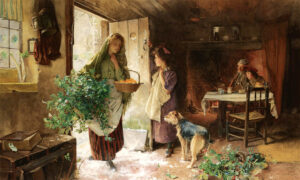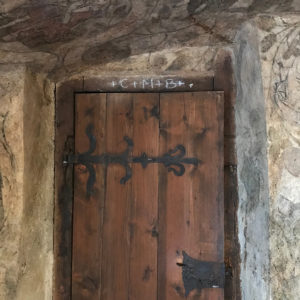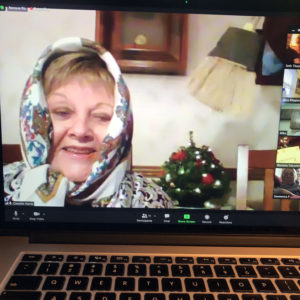Two days into the last month of the year, and here is your Convivio Book of Days Calendar for December. Last night, we lit our daily Advent candle for the first time, and opened the first window of our Advent calendar. The decorations in our house still revolve around leaves and pumpkins and Indian corn, but we will soon be bringing in the evergreens like fir and holly. Hence our cover star for this month: a watercolor from 1901 called Christmas Eve, which, in those days and for centuries before, was the day to first bring in those festive decorations. We rather like that slow approach, and that building of anticipation. The painting is by Carlton Alfred Smith, who, no doubt, appreciated these things, as well.
We are on the approach to Christmas and to the solstice of midwinter: the nights grow darker and longer, just as they’ve been doing since the solstice of midsummer in June, but now we are approaching the zenith, and the longest night of the year. The midwinter gift bearers will soon be making their appearances in their traditional lands, beginning with St. Nicholas on the night of the 5th, who is accompanied in some of those places by dark companions like the Krampus, who we are about to meet in person. You can, too, if you are local and come see us on Krampusnacht at the American German Club west of town on Lantana Road. Here’s a list of the outdoor pop-up markets where you’ll find us these next couple of weeks before Christmas. If you come, please do say hello and introduce yourself. We have one job this time of year: to dispel the night. We do that with candlelight and with the lights of the season, and we do it with the light from within. A friendly hello is the essential first step.
HOLIDAY NIGHT MARKET & FESTIVAL at SOCIAL HOUSE
Saturday December 4 from 6 to 10 PM at 512 Lucerne Avenue in Downtown Lake Worth Beach. Inspired by traditional European Christmas markets. We’ll be in the outdoor courtyard with a large selection of our Advent and Christmas artisan goods from Germany, Sweden, and Mexico, Shaker culinary herbs and herbal teas, and some of our textiles from Kei & Molly Designs and Millie’s Tea Towels.
KRAMPUSNACHT at the AMERICAN GERMAN CLUB
Friday December 10 from 7 to 11 PM at 5111 Lantana Road in suburban Lake Worth. Tickets required. It’s the night before Christkindlmarkt and you should get a babysitter, because this one is for the adults. What once was meant to frighten youngsters into good behavior, Krampusnacht in Europe has taken a twist over the decades and become a fun night of mischief and dancing, as the Krampus of German legend rules the scene. Expect to see many Krampuses at this inaugural Krampusnacht celebration! Our largest pop-up shop ever, which will carry over into Christkindlmarkt the following two days, will include Advent candles and calendars, Christmas artisan goods from Germany, Sweden, and Mexico, Shaker culinary herbs and herbal teas and soaps, Millie’s Tea Towels, our new line of tea towels and reusable bags from Kei & Molly Designs, market bags from Mexico, and more.
CHRISTKINDLMARKT at the AMERICAN GERMAN CLUB
Saturday December 11 from 2 to 10 PM and Sunday December 12 from Noon to 8 PM at 5111 Lantana Road in suburban Lake Worth. A traditional German Christmas market. Tickets required. Our largest pop-up shop ever will include Advent candles and calendars, Christmas artisan goods from Germany, Sweden, and Mexico, Shaker culinary herbs and herbal teas and soaps, Millie’s Tea Towels, our new line of tea towels and reusable bags from Kei & Molly Designs, market bags from Mexico, and more.
CHRISTMAS STOCK-UP SALE
For everyone else, there’s the Convivio Bookworks Christmas Stock-Up Sale. Spend $75 on anything and everything in our catalog, and save $10 plus get free domestic shipping: a total savings of $19.50. Just use discount code STREETFAIR at checkout. Click here to shop! We always offer free domestic shipping when you spend $60 –– no discount code is required for that. I think you’ll be amazed at all you’ll find that’s new at our website, especially if you haven’t visited in a while! Locals, you can choose Free Local Delivery at checkout no matter how much you spend… I’ll deliver on my vintage Raleigh bicycle in the 33460 zip code.
Image: “Christmas Eve” by Clayton Alfred Smith. Watercolor on paper, 1901 [Creative Commons, via Wikimedia Commons].


